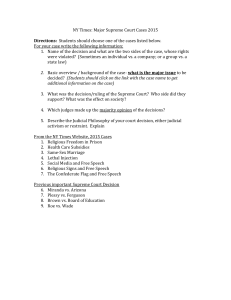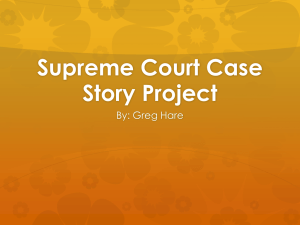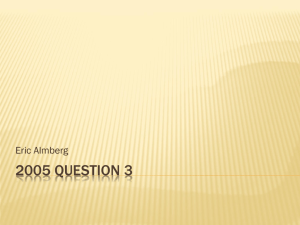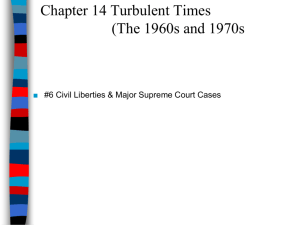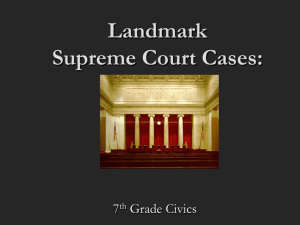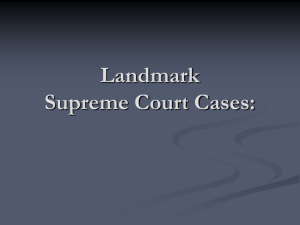Miranda Case
advertisement
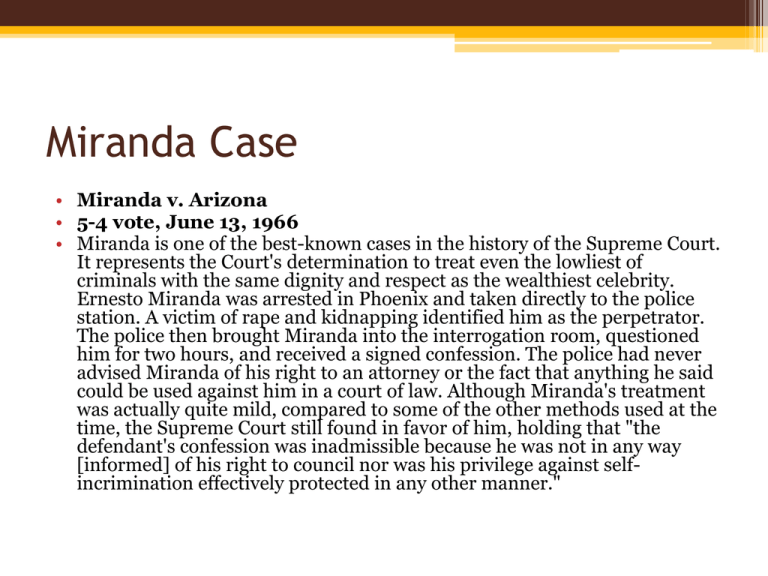
Miranda Case • Miranda v. Arizona • 5-4 vote, June 13, 1966 • Miranda is one of the best-known cases in the history of the Supreme Court. It represents the Court's determination to treat even the lowliest of criminals with the same dignity and respect as the wealthiest celebrity. Ernesto Miranda was arrested in Phoenix and taken directly to the police station. A victim of rape and kidnapping identified him as the perpetrator. The police then brought Miranda into the interrogation room, questioned him for two hours, and received a signed confession. The police had never advised Miranda of his right to an attorney or the fact that anything he said could be used against him in a court of law. Although Miranda's treatment was actually quite mild, compared to some of the other methods used at the time, the Supreme Court still found in favor of him, holding that "the defendant's confession was inadmissible because he was not in any way [informed] of his right to council nor was his privilege against selfincrimination effectively protected in any other manner." Abington Case • Abington School District v. Schempp (1963) • At Abington High School, as part of morning exercises, verse from the Holy Bible were read over the loudspeaker. The students were asked to stand and repeat the Lord's Prayer right before the flag salute. Parents were informed that students had the right to leave the room and not participate in the reading or stay in the room and participate. The Schempp family, who were of the Unitarian faith, challenged the state law claiming that it was unconstitutional in supporting religion and specific denominations at that. The Supreme Court reaffirmed the First Amendment's forbiddance of laws building the establishment of a religion. Gideon Case • Gideon v. Wainwright (1963) • Clarence Gideon, a man in Florida, was charged with breaking into a pool hall and taking money from vending machines there. In Florida, this was considered a felony. At his hearing, Gideon asked that the court appoint a lawyer to represent him since he could not afford one. The court denied him this, noting a Florida law which allowed counsel only in capitaloffense cases. Gideon went to trial and did the best he could, defending himself, but was found guilty and sentenced to five years in jail. He appealed to the Supreme Court, stating his right to counsel under the Fourteenth Amendment had been violated. The Court incorporated the Sixth Amendment's right to counsel and reversed his conviction, allowing him to be retried, this time with the help of counsel. Gideon went back to trial and this time he was found innocent of the charges. Brown Case • Brown v. Board of Education of Topeka (1954) • An African-American girl, Linda Carol Brown, was not allowed to attend a school four blocks from her house because it was for white students. Instead, she had to walk twenty-one blocks to the nearest allblack school. In a unanimous decision, the Supreme Court reversed the 1896 Plessy v. Ferguson decision saying that separate but equal is inherently unequal. In a follow up case one year later, the Court stated that local school systems should develop their own plans for desegregation to take effect "with all deliberate speed." Mapp Case • Mapp v. Ohio (1961) • Cleveland police, without a warrant, raided Ms. Mapp's home and found obscene material even though the Fourth Amendment, as incorporated by the Fourteenth Amendment's "due process clause," protected her from improper law enforcement procedures. The Supreme Court extended the "exclusionary rule" to citizens in State courts, stating that condemning unreasonable searches would be useless unless the evidence obtained in these searches was excluded Roe • Roe v. Wade (1973) • A single, pregnant, Texas woman, under the pseudonym of Jane Roe, challenged anti-abortion laws by stating that they violated her rights under the Constitution. The Fourteenth Amendment states that no state can "deprive any person of life, liberty, or property without due process of law." The Supreme Court had to decide whether a fetus was a person or not. The Court upheld Roe's claim that her right to privacy entitled her to an abortion. However, they went on to say that the right to privacy is not absolute. "A state may properly assert important interests in safeguarding health [of the mother], in maintaining medical standards [how and by whom abortions are performed], and in protecting potential life." The Court ruled on this by saying: 1. Abortions in the first three months of pregnancy cannot be limited by the states excepting that they may require that doctors perform them. 2. The state may set the conditions under which abortions may performed during the second three months of pregnancy to safeguard the health of the mother. 3. The state may outlaw abortions during the last three months of pregnancy to protect the "viable fetus," excepting cases in which the mother's life or health is threatened. Regents • Regents of the University of California at Davis v. Bakke (1978) • Allan Bakke, a Vietnam veteran, wanted to become a doctor. However, he had been turned down by eleven medical schools. He then learned that the University of California at Davis, a local medical school, had accepted minority students who were less qualified academically. In suing them on grounds of reverse discrimination, it was brought to light that the University, as part of their affirmative action program, held sixteen places each year for "disadvantaged students." The Supreme Court, in a 5-4 ruling, upheld the constitutionality of affirmative action. However, it also ruled that Bakke must be accepted to U.C. at Davis Medical School because they used race as the sole reason for reserving sixteen places for minority students. The University could consider race in admitting students. So, while upholding the policy of affirmative action, the Court decided that a system of strict quotas based on race was in violation of the Civil Rights Act of1964 and thus unconstitutional. Dred Scott • Dred Scott v. Sanford (1857) • Dred Scott, a slave owned by a Dr. Emerson, was taken from Missouri to a free state and then back to Missouri again. Scott sued, claiming that his residence in a free territory granted him freedom. In a 7-2 vote, the Supreme Court decided that Congress did not have the power to prohibit slavery in the territories, making the already repealed Missouri Compromise of1820 unconstitutional. Furthermore, the Court went on to state that blacks were not citizens of the United States and could not become citizens and therefore they could not sue in a court.
